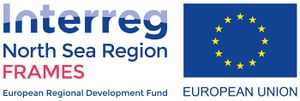Geen bewerkingssamenvatting |
Geen bewerkingssamenvatting |
||
| Regel 1: | Regel 1: | ||
<div id="emmskin-extra-row"> | <div id="emmskin-extra-row"> | ||
<h1 id="firstHeading" class="firstHeading page-title">Welcome to the wiki based platform of FRAMES </h1> | <h1 id="firstHeading" class="firstHeading page-title">Welcome to the wiki based platform of FRAMES </h1> | ||
</div> | |||
=== FRAMES: Flood Resilient Areas by Multi-Layered Safety === | |||
Floods have always been and will continue to be part of our daily reality. In fact, floods are among the world’s most common and most devastating natural hazards and have affected millions of people in Europe since the beginning of this century. Changes in our climate are increasing the risk of river and coastal flooding because sea levels are rising and rainfall patterns are becoming more extreme. Increasing flood risks call for more innovative approaches to minimize the impacts of such events. Therefore, five countries bordering the North Sea Region, Denmark, Germany, the Netherlands, Belgium and the United Kingdom, are joining forces in the Interreg North Sea Region project FRAMES. | |||
<div id="emmskin-extra-row"> | |||
<!--{{#ask: [[Category:Project]] [[Supercontext::{{PAGENAME}}]] [[Country::+]] | <!--{{#ask: [[Category:Project]] [[Supercontext::{{PAGENAME}}]] [[Country::+]] | ||
| ?Has image | | ?Has image | ||
| Regel 36: | Regel 42: | ||
| Project[Show sources]=Nee | | Project[Show sources]=Nee | ||
}} | }} | ||
--> | -->FRAMES stands for Flood Resilient Areas by Multi-layEred Safety. Traditionally, structural and static solutions were the preferred management option to defend against flooding. However, it is more and more recognized that protection alone will not be enough to make areas climate-resilient. It is also imperative to decrease the effects of flooding and look at spatial planning and disaster management as well. This so-called Multi-Layer Safety (MLS) approach is thus based on three layers: 1) protection, the primary dike system; 2) sustainable spatial planning that decreases the loss should a flood occur; and 3) disaster management, the organizational aspects related to a flood event. Together, these three layers can be tailored to local areas in order to minimize flood damage. | ||
FRAMES stands for Flood Resilient Areas by Multi-layEred Safety. Traditionally, structural and static solutions were the preferred management option to defend against flooding. However, it is more and more recognized that protection alone will not be enough to make areas climate-resilient. It is also imperative to decrease the effects of flooding and look at spatial planning and disaster management as well. This so-called Multi-Layer Safety (MLS) approach is thus based on three layers: 1) protection, the primary dike system; 2) sustainable spatial planning that decreases the loss should a flood occur; and 3) disaster management, the organizational aspects related to a flood event. Together, these three layers can be tailored to local areas in order to minimize flood damage | |||
=== Expertise WIKI on MLS === | === Expertise WIKI on MLS === | ||
Versie van 27 nov 2019 15:22
Welcome to the wiki based platform of FRAMES
FRAMES: Flood Resilient Areas by Multi-Layered Safety
Floods have always been and will continue to be part of our daily reality. In fact, floods are among the world’s most common and most devastating natural hazards and have affected millions of people in Europe since the beginning of this century. Changes in our climate are increasing the risk of river and coastal flooding because sea levels are rising and rainfall patterns are becoming more extreme. Increasing flood risks call for more innovative approaches to minimize the impacts of such events. Therefore, five countries bordering the North Sea Region, Denmark, Germany, the Netherlands, Belgium and the United Kingdom, are joining forces in the Interreg North Sea Region project FRAMES.
FRAMES stands for Flood Resilient Areas by Multi-layEred Safety. Traditionally, structural and static solutions were the preferred management option to defend against flooding. However, it is more and more recognized that protection alone will not be enough to make areas climate-resilient. It is also imperative to decrease the effects of flooding and look at spatial planning and disaster management as well. This so-called Multi-Layer Safety (MLS) approach is thus based on three layers: 1) protection, the primary dike system; 2) sustainable spatial planning that decreases the loss should a flood occur; and 3) disaster management, the organizational aspects related to a flood event. Together, these three layers can be tailored to local areas in order to minimize flood damage.
Expertise WIKI on MLS
This open source digital platform has several sections:
- All 16 pilots in the 5 countries are described in detail:
- the area and its flood risks in general,
- the implementation process of the pilot project
- the project outcomes and beyond
- Existing knowledge on MLS, resilience and climate change can be found in our glossary
- Newly developed knowledge is incorporated in
- FRAMES' Decision Support System for governance of multi-layered safety helps involved authorities to identify how governance relates to the resilience of flood prone areas;
- FRAMES' MLS Resilience Toolkit for the improved management of MLS at the catchment level
The FRAMES-video below explains Multi-Layer Safety in 90 seconds:

